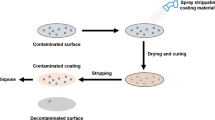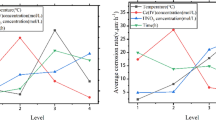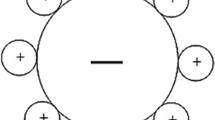Abstract
Radioactive contamination caused by nuclear leakage accidents and radioactive source diffusion accidents will pose a threat to the environment and public safety. In order to remove the contamination, an emergency decontamination technique based on strippable coating was studied. The strippable coating takes acrylate emulsion as the main film forming agent and lauryl sodium sulphate as surfactant. The decontamination performance and application dosage of the coating were tested. At the application dosage of 2.5 kg m−2, the single decontamination rate reached 92.26% for uranium dust on concrete surface, which indicates this technology is a promising method for engineering decontamination.





Similar content being viewed by others
References
Kim S, Min BI, Park K, Yang BM, Kim J, Suh KS (2018) Evaluation of radionuclide concentration in agricultural food produced in Fukushima prefecture following Fukushima accident using a terrestrial food chain model. J Radioanal Nucl Chem 316:1091–1098
Inoue K, Tsuruoka H, Le Van T, Fukushi M (2015) Contribution ratios of natural radionuclides to ambient dose rate in air after the Fukushima Daiichi nuclear power plant accident. J Radioanal Nucl Chem 307:507–512
Manuel LV, Takahashi J, Kato H, Chayama S, Hisadome K (2018) Radiocesium concentrations in soil and leaf after decontamination practices in a forest plantation highly polluted by the Fukushima accident. Environ Pollut 239:448–456
Hancock S, Byun SH, Vladimir GZ, Seymour C, Mothersill C (2019) Effects of historic radiation dose on the frequency of sex-linked recessive lethals in Drosophila populations following the Chernobyl nuclear accident. Environ Res 172:333–337
Kortov V, Ustyantsev Y (2013) Chernobyl accident: Causes, consequences and problems of radiation measurements. Radiat Meas 55:12–16
Beresford NA, Konoplev A, Skuterud L, Smith JT, Voigt G (2016) Thirty years after the Chernobyl accident: What lessons have we learnt? J Environ Radioact 157:77–89
Bevelacqua JJ (2012) Applicability of health physics lessons learned from the Three Mile Island Unit 2 accident to the Fukushima Daiichi accident. J Environ Radioact 105:6–10
Bu W, Zheng J, Guo Q, Aono T, Otosaka S, Tagami K, Uchida S (2015) Temporal distribution of plutonium isotopes in marine sediments off fukushima after the Fukushima Dai-ichi nuclear power plant accident. J Radioanal Nucl Chem 303:1151–1154
Hogan DE, Kellison T (2002) Nuclear terrorism. Am J Med Sci 323:341–349
Fu GZ, Liu JF, He BY, Zhang XX (2006) Estimate computing on the source of the nuclear and radiological terrorism events. Nucl Electron & Detect Technol 26:723–725
Corno AD, Flavio P, Araneo L, Casell F (2017) Experiments on aerosol removal by high-pressure water spray. Nucl Eng Des 311:28–34
Michael D, Kaminskia SDL, Magnuson M (2016) Wide-area decontamination in an urban environment after radiological dispersion: A review and perspectives. J Hazard Mater 305:67–86
Yang HM, Park CW, Lee KW (2018) Polymeric coatings for surface decontamination and ecofriendly volume reduction of radioactive waste after use. Prog Nucl Energ 104:67–74
Yang HM, Park CW, Lee KW (2019) Enhanced surface decontamination of radioactive Cs by self-generated, strippable hydrogels based on reversible cross-linking. J Hazard Mater 362:72–81
Feltcorn E (2006) Technology reference guide for radiologically contaminated surfaces. Environmental Potection Agency, Washington, U.S
Gray HN, Donald BJ, McClaugherty L, Kippenberger A (2001) Smart polymeric coatings for surface decontamination. Ind Eng Chem Res 40:3540–3546
Wang SY, Wang RC, Tian RC, Zhang XY, Sun QJ, Liu L (2018) Dissipative particle dynamics study on the temperature dependent interfacial tension in surfactant-oil-water mixtures. J Pet Sci Eng 169:81–95
Chen YP, Xu G, Huang JX, Eksteen J, Liu XF, Zhao ZD (2019) Characterization of coal particles wettability in surfactant solution by using four laboratory static tests. Colloid Surf A- 567:304–312
Gao T, Li CH, Zhang YB, Yang M, Jia DZ, Jin T, Hou YL, Li RZ (2019) Dispersing mechanism and tribological performance of vegetable oil-based CNT nanofluids with different surfactants. Tribol Int 131:51–63
Leng WG, Zhou SX, Gu GX, Wu LM (2012) Wettability switching of SDS-doped polyaniline from hydrophobic to hydrophilic induced by alkaline/reduction reactions. J Colloid Interface Sci 369:411–418
Fujii K, Ochi K, Ohbuchi A, Koike Y (2018) Evaluation of physicochemical properties of radioactive cesium in municipal solid waste incineration fly ash by particle size classification and leaching tests. J Environ Manag 217:157–163
Acknowledgements
This work was financially supported by Outstanding Talents Innovation Foundation of Henan Province (No. 154200510029).
Author information
Authors and Affiliations
Corresponding author
Ethics declarations
Conflict of interest
Their authors declare that they have no conflict of interest.
Additional information
Publisher's Note
Springer Nature remains neutral with regard to jurisdictional claims in published maps and institutional affiliations.
Rights and permissions
About this article
Cite this article
Wang, J., Liu, G., Zhao, L. et al. Research on nuclear emergency decontamination technology based on strippable coating. J Radioanal Nucl Chem 322, 1049–1054 (2019). https://doi.org/10.1007/s10967-019-06790-5
Received:
Published:
Issue Date:
DOI: https://doi.org/10.1007/s10967-019-06790-5




